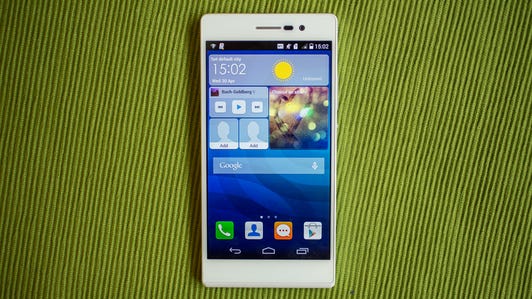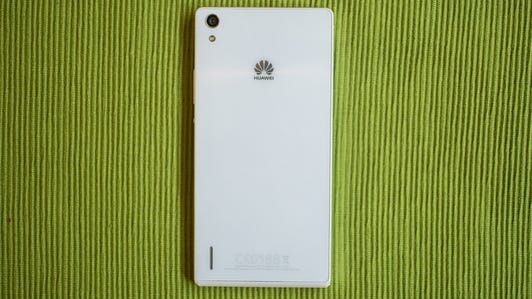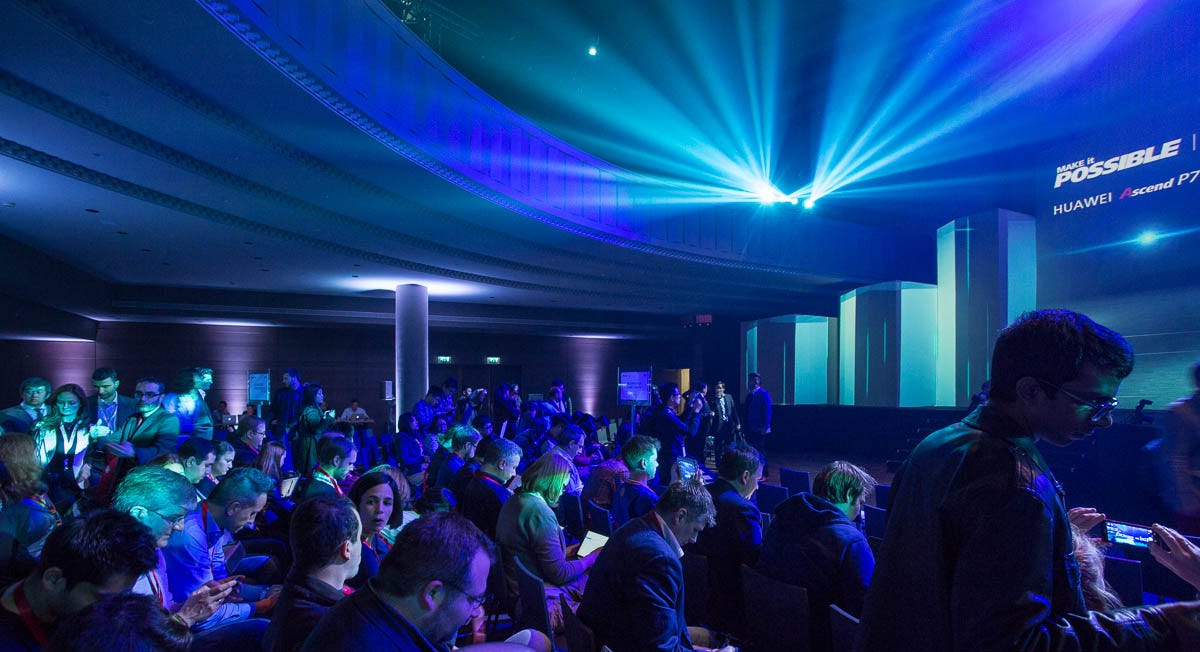
Stephen Shankland/CNET
PARIS — Huawei on Wednesday launched its Ascend P7 , a new flagship Android model with which the Chinese company will try to improve on its third-place ranking in the smartphone market.
The company signaled the arrival of the new phone at a press event here with signs that said, “Huawei Ascend P7 global launch.” The phone, which runs Google’s Android mobile operating system, is a successor to the company’s P6.
The Ascend P7 has many of the necessary competitive specs for the flagship market — a 5-inch 1,920×1,080 display, 4G LTE networking, a 1.8GHz quad-core processor, a 13-megapixel rear-facing camera, an 8-megapixel front-facing camera, and a Gorilla Glass 3 housing on both its front and back. It’s built in the inevitable slab shape, has a trim thickness of 6.5mm, and runs Android modified with Huawei’s Emotion interface.
Huawei Ascend P7 shows off its narrow glass body (pictures)






+16 more
That’s nice — but it’s tough standing out in the Android crowd.
The Ascend P7 will compete chiefly with a handful of other top-end phones with Google’s Android OS, including the Samsung Galaxy S5 , the HTC One M8 , and the Sony Xperia Z2 .
It’s also a rival to phones using other mobile operating systems such as the Lumia 1020, a Windows Phone device that Microsoft sells now that it has acquired Nokia’s phone business, and of course the iPhone 5S from Apple.
The phone will be available initially in June in dozens of European and Asian countries for a price of 449 euros (US$625) unlocked. Huawei will expand beyond that later, including to the US. “We will sell this worldwide,” said Richard Yu, chairman of Huawei Devices and chief executive of the company’s Consumer Business Group, at the event here.
Much of Huawei’s success has come from its strong position in its home market. While the company has made strides in select countries around the world, it remains essentially shut out in key markets such as the US, where its brand is virtually nonexistent despite a campaign to build awareness.


Stephen Shankland/CNET
Huawei doubled its global brand awareness to 52 percent and has risen to third in the smartphone market, but “we won’t stop there,” Yu said. “We want to become better and better and better. We will invest so many resources on the product, the innovation, on R&D, the marketing — everything. We are improving our service and our quality.”
In the first quarter of 2014, Huawei held the No. 3 spot in the worldwide smartphone market, according to analyst firm IDC — a notable accomplishment but hardly a secure position. Most of that market share comes from China.
The 13.7 million phones that Huawei shipped accounted for only 4.9 percent of the market, well behind No. 2 Apple with 15.5 percent of the market and No. 1 Samsung with 30.2 percent. Huawei, though, is growing faster than either of those rivals, with shipments surging 47 percent from the year-earlier quarter compared to Apple’s 16.8 percent growth and Samsung’s 22 percent growth.
From selfies to ‘groufies’
Like HTC and Apple, Huawei is trying to get an edge through a high-class design, including a 7-layer surface treatment on the back. “We put it in to achieve this high-quality look and feel,” said Joonshu Kim, a vice president of Huawei Mobile Devices. It comes with a “luxurious metallic appearance and exquisite micro pattern,” he said, with a depth that will remind people of fish swimming beneath the surface of the water.
The Ascend P7 also has 4G LTE network support that works in many parts of the world, said Clement Wong, global go-to market director for Huawei. It’s got dual antennas to improve reception, he added.
Huawei is hoping the phone will be considered cool in another way, too: By distributing heat throughout the phone, it runs 7 degrees Celsius lower and therefore is more comfortable to hold, Wong said.
The phone’s “double-C” design gives it a bezel that curves front to back at the bottom of the phone and side-to-side across the top of the phone. The result is something like two curves interlocking.


Now playing:
Watch this:
The skinny, glass, selfie-loving Huawei Ascend P7
1:44
The 6.5mm thickness of the Ascend P7 makes it a tad slimmer than the iPhone 5S at 7.6mm and the Galaxy S5 at 8.1mm, Kim said. The chip is a HiSilicon Kirin 910T processor, and the phone has a 2,500mAh battery.
The pixel density is 445 pixels per inch on the Ascend P7, compared to the iPhone 5S’s 326ppi and 432ppi on the Galaxy S5.
The rear-facing camera, with a 13-megapixel resolution and higher-end image-processing chip, can handle low-light circumstances with sensitivity settings that will reach ISO 3,600.
Meanwhile, the phone’s 8-megapixel front-facing camera is a departure from the industry norm and is designed to produce better self-portraits, said Changzhu Li, head of technology planning.
“Consumers always want high-quality selfies,” Li said.
That’s more pixels than the iPhone 5S’s 1.2-megapixel camera and the Samsung Galaxy S5’s 2-megapixel camera, but Huawei also built in a five-lens system for better clarity and lower chromatic aberration. Basically, the company is putting rear-facing camera technology into the front-facing camera.
That means Huawei can take front-facing camera photos a step further — it is promoting “groufies,” group self-portraits, including those with a panoramic mode. “With a groufie,” Li said, “you can take much more background or include more bodies in your selfie pictures.”



